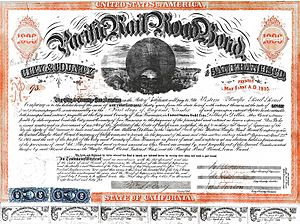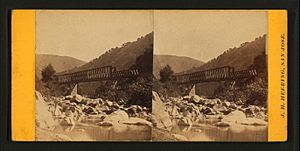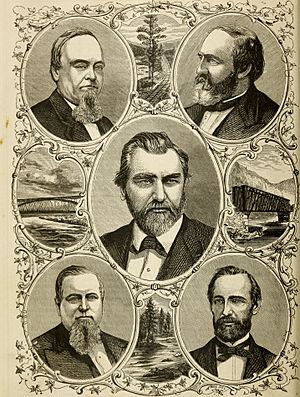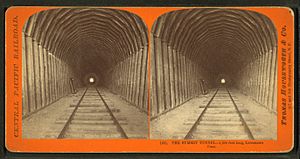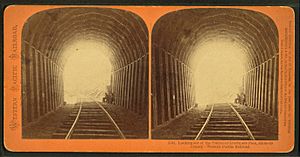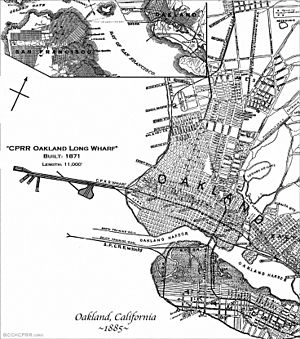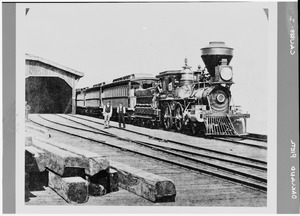Western Pacific Railroad (1862–1870) facts for kids
The Western Pacific Railroad (1862-1870) was a company started in 1862. Its main goal was to build a railway line from Sacramento, California, all the way to the San Francisco Bay. This railway was a very important part of the First Transcontinental Railroad, which connected the East Coast to the West Coast of the United States.
After the railway was finished, reaching Alameda Terminal on September 6, 1869, and then the Oakland Pier on November 8, 1869, the Western Pacific Railroad joined with the Central Pacific Railroad in 1870. The Oakland Pier became the final stop for the transcontinental railway on the Pacific coast.
| W.P.R.R. | |
| Overview | |
|---|---|
| Locale | San Jose to Sacramento; Niles to Alameda/Oakland |
| Dates of operation | 1864–1870 |
| Successor | Central Pacific Railroad |
| Technical | |
| Track gauge | 4 ft 8 1⁄2 in (1,435 mm) standard gauge |
| Length | 123 miles San Jose to Sacramento; 26.5 miles Niles to Oakland |
Contents
Building the Western Pacific Railroad
The Western Pacific Railroad (1862-1870) was started in December 1862. A group of important businessmen, including Timothy Dame, Charles McLaughlin, and Peter Donahue, led this effort. They were also involved with the San Francisco and San Jose Railroad.
Their plan was to build a railway from San Jose north to Niles. From there, it would go through Niles Canyon, then to Pleasanton, California, and over Altamont Pass to Stockton. Finally, it would head north to Sacramento. The idea was that the transcontinental railway would use this Western Pacific line to reach San Jose and then connect to San Francisco.
In January 1864, the San Francisco and San Jose Railroad was finished. Soon after, the Western Pacific began getting ready to build its line. On October 31, 1864, the Central Pacific Railroad gave the Western Pacific all its rights to build the railway between Sacramento and San Jose. This included special land grants from the government.
Constructing the Railway Line
Building the Western Pacific Railroad started in February 1865 near San Jose. Many workers, including about 500 Chinese laborers, helped prepare the ground and lay tracks. These Chinese workers had also helped finish the San Francisco and San Jose Railroad.
By October 1866, the Western Pacific had laid about 20 miles (32 km) of track. This reached from San Jose into Alameda Cañon (now Niles Canyon). The first trains left San Jose for Vallejo Canyon on October 2. The company had also planned the rest of the route through Niles Canyon, Livermore Valley, and over Livermore Pass (now Altamont Pass). It was supposed to go all the way to Stockton and Sacramento.
However, the company ran out of money and had to stop building. One problem was that some government land grants were not available because Mexican land grants had already been made in those areas.
New Owners and New Plans
In June 1867, the "Big Four" — a group of five powerful businessmen from the Central Pacific Railroad — took over the struggling Western Pacific. They bought its assets and helped it get back on track.
Later, the Central Pacific decided that the route through San Jose to San Francisco was too long. They thought it would be better to use ferryboats from a new pier in Oakland. This pier, called the Oakland Pier, would be the main western end of the railway. This decision was finalized in April 1868.
Building the Western Pacific line from Sacramento south to Stockton and beyond, including Livermore Pass, began in early 1868. After the 1868 Hayward earthquake damaged another local railway, the Central Pacific also bought it. This allowed them to connect to the Alameda Terminal for ferry service to San Francisco.
After the Central Pacific finished the western half of the first transcontinental railroad in May 1869, workers moved to California. They started building a new rail line from Vallejo Mills (now Niles) north toward Oakland. Other workers continued building the railway eastward from Alameda Cañon.
By July 1869, about 500 Chinese workers were building the line toward Oakland. On other parts of the line, more than 2,000 men, mostly Chinese, were working. They were building eastward from Alameda Cañon and southward from Sacramento. This part of the line had two big challenges: digging a 1,200-foot (366 m) tunnel through hard rock near Livermore Pass and building a bridge over the San Joaquin River at Mossdale.
Reports from the time noted that Chinese workers were paid less than white workers but often did more work. For example, in July 1869, white men working on the tunnel were paid $45 per month plus food, while Chinese workers were paid $37.50 per month and had to buy their own food.
By mid-August 1869, the railway was finished through Alameda Cañon into Livermore Valley. The tunnel at Livermore Pass was completed by the end of August. The first passenger train went through the tunnel on September 1. Workers then focused on finishing the San Joaquin River bridge, which was the last big piece to connect Sacramento to San Francisco Bay.
The Railway Opens for Service
By September 5, 1869, the railway from Vallejo Mills (Niles) to San Leandro was complete. It connected to existing tracks that led to the Alameda Wharf. The very next day, Monday, September 6, 1869, the San Joaquin River railroad bridge at Mossdale was finished.
That evening, the first train from Sacramento to reach San Francisco Bay arrived at the Alameda Terminal. A cheering crowd greeted it. Passengers then took a ferryboat, the Alameda, to San Francisco. This opening was rushed to be ready for visitors attending the 1869 California State Fair in Sacramento.
The completion of the San Joaquin River bridge and the first train to Alameda are remembered by two California Historical Landmarks. One is in Lathrop (CHL 780-7) and the other in Alameda (CHL 440).
Two months later, the railway connection to the San Francisco and Oakland Railroad was ready. The Central Pacific's Oakland Pier was also expanded. On November 8, 1869, the first transcontinental train used the expanded Oakland Pier. It traveled through Oakland on the Western Pacific Railroad to Sacramento and then continued east on the Central Pacific Railroad. The city of Oakland held a big celebration to welcome this historic train.
After November 1869, the Oakland Pier became the main Pacific coast stop for all transcontinental trains. Alameda then went back to being a local train service.
Locomotives of the Western Pacific
The Western Pacific Railroad had a total of ten locomotives (train engines).
- The first five were built in 1864 by Norris Locomotive Works in Pennsylvania. One was a small 12-ton engine, while the others were larger, weighing 30 to 33 tons.
- Baldwin Locomotive Works built three more 30-ton engines in 1866.
- Mason Machine Works built two similar engines in 1867.
One special locomotive was named Mariposa. It was built in 1864 and is the only surviving engine from the original Western Pacific. You can see it today at the Travel Town Museum in Griffith Park, Los Angeles, California.
Changes to the Route Over Time
In 1870, the Western Pacific Railroad officially ended. Its railway lines were taken over by the Central Pacific Railroad. From then on, maps showed the Western Pacific route as part of the Central Pacific.
In 1879, the Central Pacific made its route from Sacramento to the Oakland Pier shorter. They built a new line from Sacramento to Benicia. Trains would cross the Sacramento River there using huge train ferries, the Solano and Contra Costa. From Port Costa, the line followed the coast to Richmond, Berkeley, and Oakland.
Because of this new, shorter route, the original 1862–1869 Western Pacific route through Altamont Pass and Niles Canyon became a less important, secondary route.
In 1930, the train ferry service stopped. Trains then used the new steel Benicia-Martinez Bridge to cross the Carquinez Strait from Benicia to Martinez. This bridge is still used today.
In 1888, the Central Pacific's routes were taken over by the Southern Pacific Railroad.
Historical Markers and Monuments
- California Historical Landmark No. 780.7 marks the site where the Pacific Railroad was completed. It's near the San Joaquin River in Lathrop, California.
- California Historical Landmark No. 440 marks the Alameda Terminal of the Transcontinental Railroad. It is located in Alameda, California.
The Newer Western Pacific Railroad
It's important to know that a *new* railway company, called the Western Pacific Railway Company, was formed in 1903. This new company wanted to compete with the Southern Pacific Railroad. It built routes between Oakland, San Jose, Sacramento, Stockton, and Salt Lake City. East of Sacramento, its routes were very similar to the original 1862 Western Pacific Railroad lines.
In 1916, the Western Pacific Railway Company went out of business. Its assets were bought by another new company, The Western Pacific Railroad Company.
Today, parts of the original 1862 Western Pacific Railroad route are still used. The Niles Canyon Railway operates a tourist train on a section of the old route. This helps preserve the history of the Western Pacific Railroad (1862–1870), which played a key role in completing the first transcontinental railway to the Pacific coast.


